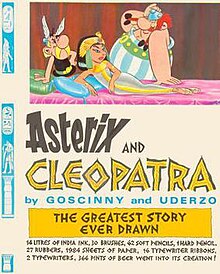Plot Summary
In Egypt, Julius Caesar belittles the Egyptians for being no longer a great civilisation compared to the Romans. Infuriated to hear this, Cleopatra, queen of the Ptolemaic Kingdom, makes a wager with him that she can prove that they are still great by having a grand palace constructed in Alexandria within three months. Caesar naturally accepts the wager. To handle the construction project, Cleopatra assigns Edifis, a man who claims to be the best architect in her kingdom, to build the palace, promising to reward him greatly with gold, but warns he will be fed to the sacred crocodiles of the Nile if he fails. Concerned with the task he has been given, Edifis decides to travel to Gaul, in order to request aid from his old friend Getafix, a druid who supplies his village with a magic potion that gives them superhuman strength to resist the Romans.
Getafix agrees to help, and travels back with Edifis to Egypt, accompanied by Asterix, Obelix, and Dogmatix - Obelix's new pet dog. As they begin to help with construction, Edifis flatly refuses the assistance of his rival, Artifis, over their work ethics. Angered by this, Artifis attempts to sabotage the palace's construction, but is thwarted by the Gauls. Infuriated by this, he assigns a henchman, Krukhut, to have Asterix and his friends trapped within a pyramid, only to be shocked when he learns they escaped - thanks to Dogmatix. To be rid of them, Artifis attempts to frame them by sending a poisoned cake to Cleopatra, who promptly accuses the Gauls of trying to kill her. Seeking to prove their innocence, Getafix makes out the cake is safe to eat - through the use of a potion the group secretly use - while claiming her food taster, who was poisoned by the cake, is suffering indigestion from the rich food he tastes.
After being released, the Gauls find Edifis missing from the construction site, and suspect Artifis of kidnapping him. Asterix and Obelix promptly raid his home, where his henchman panics and reveals the missing architect was imprisoned in the basement. As punishment for their actions, the Gauls make Artifis and his henchman help with construction, but without the aid of the magic potion. As construction nears completion, Caesar becomes suspicious over the Egyptian's speed and assigns an Egyptian spy, Mintjulep, to investigate. When he returns, Mintjulep explains about the presence of the Gauls and their magic potion, which prompts Caesar to order several of his legions to assault the construction site and capture them. Despite defending against the attack, Asterix and Dogmatix find themselves forced to deliver news of the attack to Cleopatra, when the Romans use catapults to shell the building site.
Caesar finds himself shamed by Cleopatra, who calls him out for acting dishonourably with their wager, upon visiting the site in haste. To make amends with her, he promptly has his legions repair the damage they caused to the palace. Construction is eventually completed on time, much to Cleopatra's delight, allowing Edifis to be rewarded with gold; he and Artifis also reconcile their differences and agree to work together on future projects. Delighted that Caesar honoured the conditions of their wager, Cleopatra thanks the Gauls, gifting Getafix with several papyrus manuscripts from the Library of Alexandria. The group soon return home to Gaul, where Obelix attempts to give his menhirs an Egyptian obelisk look, only to be criticised by Chief Vitalstatistix for doing so.
